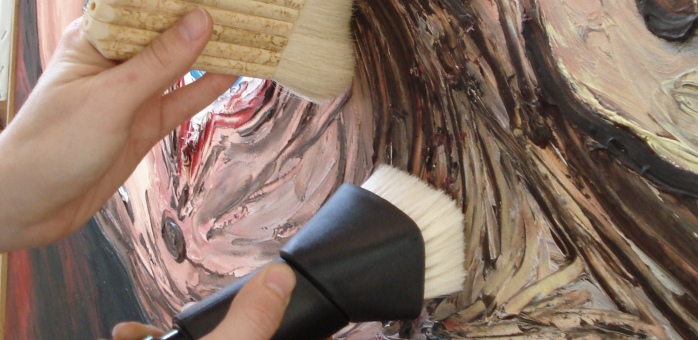
La conservación y restauración de las obras que alberga el MACVAC está gestionada por los Servicios de Restauración de la Diputación Provincial de Castellón. Cada año se realizan labores constantes de conservación preventiva, mantenimiento y acondicionamiento y restauraciones completas. Desde esta página se puede acceder a un tríptico informativo.
The main task of the SRCBC Department of Contemporary Art at MACVAC focuses on the conservation, restoration and value of all artistic manifestations, such as painting, sculpture, graphic document, decorative arts, design objects, installations, audiovisual or multimedia elements, etc. that, from a chronological perspective correspond to a period of time from the avant-garde to the present day.
Due to the particularities of many of these pieces, the establishment of conservation measures and the design of specific interventions, is carried out through multidisciplinary groups between the different Areas/Departments. They work together and in a coordinated manner, in order to solve all those conservation problems that differ from those considered "traditional".
One of the main characteristics of Contemporary Art is the great heterogeneity of materials and techniques present, united in a double concept-matter dimension according to a different creative philosophy.
The interrelationship of internal factors (constituent materials, diversity, quality, incompatibility, level of experimentation, greater sensitivity, willingness of the artist to give his work an ephemeral character, etc.), with those of external order (environmental conditions during exhibition, storage and transport, volume of work, etc.), are established as responsible for their alteration and deterioration.
Artists make use of traditional artistic means with unconventional ones, abandoning charges and treatises, introducing newly created industrial elements (resins, synthesis pigments, dyes, postformed, etc.), with elements until not long ago improper in the field of art (cement, plastics, rubbers, electrical or audiovisual components, elements of organic origin, etc.), being able to leave spare parts, copies, assembly instructions , include degradation as an artistic element or seek the active participation of the viewer in order to provoke certain sensitive experiences (view, sound, touch and smell), etc.
In addition, it is possible to take into account the position of the artists in the face of the intervention of the pieces. Since they may be favorable, be against any treatment, exercise their right to intervene or work together with the restorer.
In this sense, the application of preventive conservation in all areas related to works of art becomes indispensable.